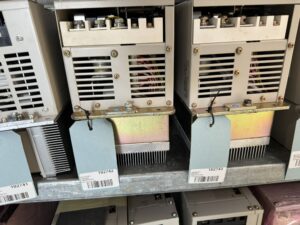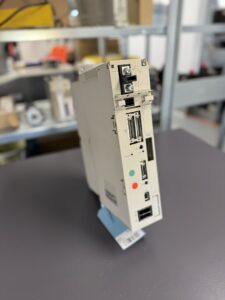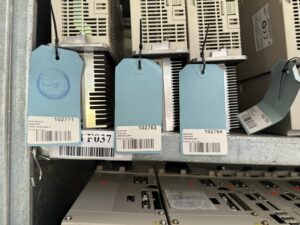26.04.2025 by Viktor Siebert
Siemens-Yaskawa Joint Venture in Control and Drive Systems – An Overview
Siemens-Yaskawa Joint Venture in Control and Drive Systems – An Overview
Approximately 15 years ago, Siemens and Yaskawa provided a powerful joint solution in the field of CNC controls and drive technology. The renowned Yaskawa-Siemens control systems (e.g., 840DI) and their corresponding servo drives were widely installed in machine tools from reputable manufacturers. However, since the dissolution of this joint venture in 2018, many operators of these machines face significant challenges—especially concerning spare part procurement and maintenance.
Today, these systems are technologically outdated, and official spare parts are scarcely available. Often, customers feel left alone with their issues because neither Siemens nor the original machine manufacturers claim responsibility. This is exactly where our company steps in:
For years, we have specialized in the repair and maintenance of Yaskawa drive technology. With our extensively stocked warehouse, we have access to numerous modules, servo motors, encoders, and circuit boards—components that are no longer regularly available on the market. Thanks to our broad network and continuous investment in spare parts, we can respond swiftly to customer needs and ensure machines return to reliable operation.
We help minimize downtime and avoid costly new investments. Whether repairing a defective servo drive or replacing a damaged encoder, our experts possess the expertise and necessary components to quickly and reliably resolve any issues.
Here is a brief insight into our warehouse inventory: we keep several modules in stock, regularly refurbishing them and offering them as exchange parts.
Drives / Inverter / Converter
Servo Drive 1/2/3 Axis:
SGDK-050505AEA, SGDK-101010AEA, SGDK-0505AEA, SGDK-1515AEA, SGDK-2020AEA, SGDK-3030AEA, SGDK-05AEA, SGDK-10AEA, SGDK-50AEA, SGDK-60AEA
Converter:
CIMR-MRXN27P5, CIMR-MRXN2011, CIMR-MRXN2015, CIMR-MRXN2018, CIMR-MRXN2030
Inverter:
CIMR-MXN27P5, CIMR-MXN2011, CIMR-MXN2015, CIMR-MXN2018, CIMR-MXN2030
Servo Motors
SGMGH-03A5A-SE15, SGMGH-03A2A-SE12, SGMGH-05K5A-SE19, SGMGH-09A5A-SE11, SGMKS-13ACA-SE11, SGMKS-20A5A-SE11, SGMPH-08A1A-SE31, SGMPH-08AAA-SE11



For more details about our Yaskawa repair services, visit: Yaskawa Drive Repairs
📞 Feel free to contact us if you have any questions about your Yaskawa drive technology!
Siemens-Yaskawa Joint Venture in Control and Drive Systems – An Overview
Brief History of the Joint Venture
The joint venture between Siemens AG and Japan’s Yaskawa Electric Corp. in the field of control and drive technology was established on October 1, 1999. Operating under the name Yaskawa Siemens Automation & Drives Corp. (YSAD), both companies combined their strengths to capture new market shares. Siemens primarily contributed its CNC control technology (Sinumerik) and automation expertise, while Yaskawa brought in its expertise in servo drives and strong presence in the Japanese market. The joint venture aimed to jointly develop and market industrial drive systems, especially targeting industries such as paper, textiles, films, and other industrial applications. Additionally, this partnership enabled Siemens CNC controls to enter the Japanese machine tool market through Yaskawa’s existing customer base. For example, Siemens CNC technology (such as Sinumerik 840D) was integrated with Yaskawa hardware and sales structures to offer powerful, integrated solutions.
Reasons for the Dissolution of the Joint Venture
After nearly two decades, changing market requirements and partner strategies eventually led to the dissolution of the joint venture. In July 2018, Siemens sold its shares in YSAD to Yaskawa, making Yaskawa the sole owner as of November 1, 2018. Yaskawa officially justified this step by citing changed industrial conditions and new strategic directions. Developments related to Industry 4.0 and Yaskawa’s own innovation strategy (“i³-Mechatronics”) necessitated a closer integration of joint venture activities into the parent company. Full ownership allowed Yaskawa greater flexibility to adapt to these changes and seamlessly incorporate the former joint products into its product strategy. Siemens, in turn, increasingly focused on its own digitization and automation portfolios, making direct involvement in the joint venture strategically unnecessary. Consequently, the joint venture effectively ended, and YSAD was renamed Yaskawa Automation & Drives Corp. (YAD), a wholly-owned subsidiary of Yaskawa.
Products of the Cooperation: Controls and Drives
The Siemens-Yaskawa cooperation produced several CNC control systems and drive solutions, notably the Yaskawa Siemens 840DI and 830DI CNC control series. These were adapted versions of Siemens’ Sinumerik 840D control system, developed or branded jointly. Siemens provided the control software and hardware platforms, while Yaskawa handled integration and distribution, particularly in Japan. Servo drives and motors from Yaskawa were integrated with these CNC controls, typically employing Yaskawa’s Servopack series (e.g., Sigma series) for axis drives, which communicated seamlessly with the Sinumerik control. Additionally, Yaskawa spindle drives (frequency converters for main spindles) were sometimes integrated. Thus, the cooperation encompassed a complete control and drive solution.
Applications in Machines by Matsuura and Star Micronics
Prominent machine tool manufacturers such as Matsuura and Star Micronics utilized these Siemens-Yaskawa systems extensively in the early 2000s. Matsuura’s V.Plus series vertical machining centers and Star Micronics’ ECAS series turning machines featured these controls, offering customers advanced CNC functionality and networking capabilities.
Current Situation: Spare Parts, Support, and Challenges
Since the joint venture no longer exists and the systems are no longer produced, machine operators now face significant challenges regarding spare parts and service support. Spare parts have become increasingly scarce, leading frequently to machine downtime. Operators are therefore compelled either to source used spare parts, find specialized service providers, or implement retrofit solutions to ensure the future viability of their machines.